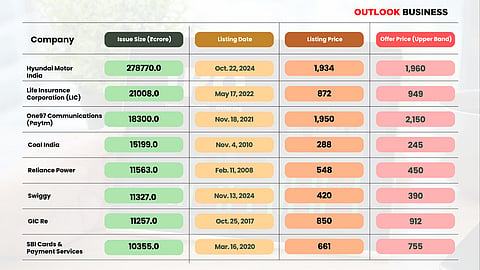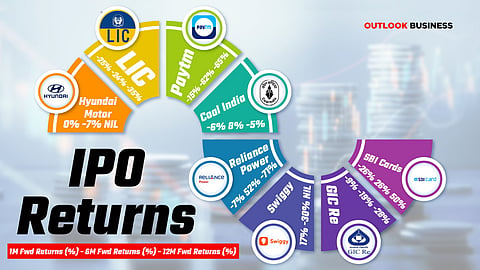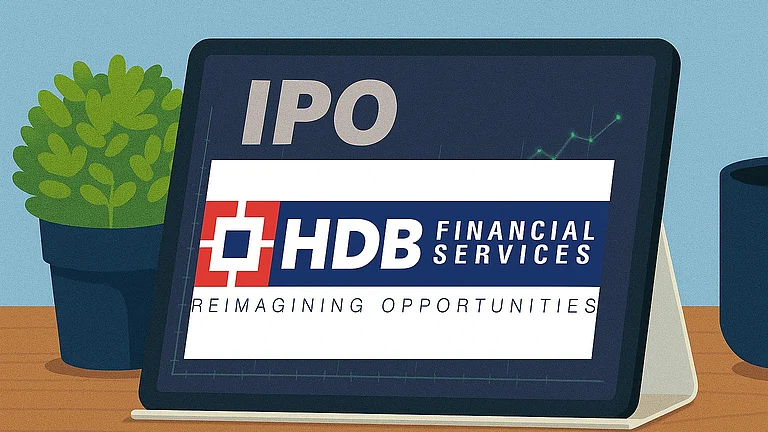As HDB Financial’s ₹12,500-crore public offer opened for bids today, the company joined the ranks of India’s largest IPOs, standing fifth in line. Ahead of it in the list, are public offers from Hyundai Motor India, Life Insurance Corporation (LIC), Coal India and One97 Communications, the parent company of Paytm.
HDB Financial Joins India’s Big-League IPO Club; But Will it Break the Post-Listing Curse?
HDB Financial’s ₹12,500-crore IPO joins the ranks of India’s largest public offers, but subdued demand and past trends raise questions on listing-day gains
However, if issue size alone remains the benchmark, the historical performance of such large-scale IPOs offers a more sobering perspective. Five out of the eight IPOs in India’s history with issue sizes exceeding ₹10,000 crore failed to deliver listing gains. Of the three that did, the gains were rather modest, peaking at around 22%.

Mega-IPO, Flop Listing
A closer look at the last eight mega listings reveals a worrying pattern. One month in, these stocks had already lost an average of 9%. Within the next six months, losses deepen to 20% and holding on for a year cuts down value by quarter, a report by Samco Securities calculated.
Paytm appears to be the most striking example of this big-ticket flop show. Its ₹18,300 crore debut in November 2021 was supposed to be a landmark moment for Indian fintech space. Instead, it wiped out 65% of its value within a year, leaving investors stunned. Life Insurance Corporation (LIC), despite its stature and government backing, followed a similar trajectory, down 35% a year after raising over ₹21,000 crore.

This trend has also held true in recent times as Hyundai Motor’s record-breaking ₹27,870 crore IPO, the biggest in the country’s history, is already trading 7% below its listing price just six months in. Like an outlier, Swiggy offered a turnaround with a 17% gain in the first month, but soon reversed course and slipped into 30% losses by month six.
Only SBI Cards has been a true outlier. Listed in March 2020 during peak pandemic uncertainty, it defied the odds and delivered a 50% return within a year.
For now, the verdict on mega IPOs is clear: flashy launches and large issue sizes don’t guarantee long-term gains. Such a pattern warrants a note of caution for investors considering HDB Financial’s offer. While large IPOs often generate strong interest among retail investors, the sheer scale of these issues can dilute listing-day excitement. An offer as big as this, typically ensures that most investors are able to secure an allotment, reducing the urgency and scarcity that often drive strong market debuts.
In contrast, there’s a growing preference among investors for smaller companies, particularly in the SME segment, where limited supply and higher perceived growth potential often result in stronger retail participation and sharper listing gains.
Kranthi Bathini, Director – Equity Strategy at WealthMills Securities, pointed another possible reason for the muted performance of large IPOs: much of the growth story is already priced in. “These high-profile IPOs attract a lot of attention, and by the time they reach the market, their valuations often reflect much of the anticipated upside,” he said.
Alarm Bells For HDB Financial?
HDB Financial’s pricing has also drawn scrutiny. The IPO’s price band of ₹700–740 per share marked a sharp drawdown from the company’s earlier grey market trends, where unlisted shares had been changing hands for ₹1,200–1,350 apiece, nearly 70–80% higher than the current offer price. Unsurprisingly, the grey market premium has cooled significantly since the announcement, now hovering around just 10%.
This decline in the grey market premium reflects shifting expectations. Some early investors in the unlisted market had likely anticipated higher listing gains, however, the actual price band has tempered those assumptions, pushing those investors into losses.
The grey market premium, which refers to the extra price investors are willing to pay for IPO shares ahead of their official listing, offers a glimpse into market sentiment. For instance, if shares are offered at ₹100 and trading at ₹120 in the grey market, the GMP would be ₹20. While often seen as an indicator of potential listing performance, it remains unregulated and doesn’t guarantee results.
Even with the drop in GMP, analysts now view HDB Financial’s valuation as reasonable when benchmarked against listed peers such as Bajaj Finance and Shriram Finance. At 3.72 times its FY24 book value, the company’s pricing appears more aligned with broader market standards than the inflated valuations seen in the unlisted market earlier.
Reasonable valuations are, of course, a welcome sign. But past experience with high-profile IPOs, like Hyundai Motor, Paytm, LIC, and SBI Cards shows that premium pricing does not always translate into strong market debuts. In contrast, Coal India’s IPO, priced at ₹245, and was widely seen as undervalued, leading to robust post-listing gains.
Now while comfortable valuations are a positive for HDB, whether or not its listing will manage to break the ceiling for big-ticket IPOs still remains to be seen. In the past, lofty prices for other mega issues like Hyundai Motor and Paytm and premium pricing for LIC and SBI Cards saw these IPOs fail to put a blockbuster listing. On the flipside, Coal India was seen as undervalued at its offer price of Rs 245, leading to stellar gains in the stock post its market debut.
The HDFC Trust
While the past paints a rather somber picture for mega IPOs, HDB Financial also edges apart with a strong brand name. Armed with healthy financials, decent valuations and the HDFC brand pedigree, the NBFC may prove to be the exception in the lot.
HDB Financial Services comes armed with impressive credentials that distinguish it from previous mega IPO failures. As the 7th largest diversified retail-focused NBFC in India with a gross loan book of ₹902.2 billion as of March 2024, the company benefits from the unassailable brand power of HDFC Bank, India's second-largest private bank.
Brokerages are also rallying in support for HDFC Bank’s non-bank financial arm. This also stands in contrast with other mega IPOs as most faced a mixed reaction from brokerages.
Chola Securities sees HDB’s post-issue Price to book (P/BV) stands at 3.88x and Price-to-Earnings ratio (PER) at 28.2x, aligning well with the industry average and a sign for upside on relative valuation multiples to peers.
Ishank Gupta, Research Analyst at DRChoksey FinServ echoed a similar sentiment, touting the issue as attractively priced considering its parentage, peer group ROA (Return on Asset) average and growth potential.
Meanwhile, analysts at Sharekhan see a long runway for growth for HDB on the back of its strong parentage and much smaller in size as compared its core peer (Bajaj Finance). “Additionally, favourable macro environment will act as tailwind for the sector in the near to medium term. We expect healthy listing gains and remain assertive from a medium to long-term perspective,” Sharekhan said.
As of now, HDB Financial’s ₹12,500-crore public offer had been subscribed just 28% by 3 pm, indicating tepid demand in early bidding. That said, the company has already secured ₹3,368 crore from anchor investors, including marquee names such as LIC, BlackRock, Goldman Sachs, and the Abu Dhabi Investment Authority.
While the backing of marquee investors adds heft to HDB Financial’s public offering, and its robust fundamentals position it as a credible long-term contender, the immediate challenge lies in post-listing performance. The key question is whether enough liquidity will remain in the secondary market to sustain momentum after the debut. With heavyweight IPOs like Hyundai Motor and LIC struggling to achieve this, all eyes are now on HDB to see if it can buck the trend.

